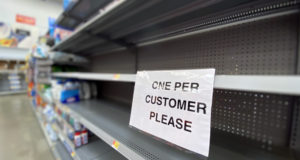Big Food is finally giving in to consumers on GMO labeling — sort of. By the end of 2017 a new app will tell you if up to 30,000 products from some of the world’s biggest food and beverage brands contain genetically modified ingredients, commonly knowns as GMOs.
Consumers would us a smartphone to scan a QR code, which would provide detailed nutritional information about the food, Time reported. The app then would tell the consumer if the food is non-GMO.
Additionally, that information will also be available on the web, a SmartLabel fact sheet indicates. Information will also be displayed at SmartLabel.org and from customer service desks.
SmartLabel’s website is still under construction. According to the site and a press release, SmartLabel will offer the following information:
- Nutrition
- Allergens
- Advisories
- Brand information
- Ingredients including GMO.
Significantly, the labels themselves will not disclose GMO information.
Not Yet Available
Time reported that the following companies have agreed to participate in the SmartLabel effort, although the list is growing
- Pepsi, which also owns Frito-Lay.
- ConAgra Foods
- Hormel
- Campbell Soup
- Land O’Lakes
- Coca-Cola.
- Nestle
- Hershey
- General Foods
Major grocers are also participating in SmartLabel, which is sponsored by the trade group Grocery Manufacturers Association.
The Best Deals On Non-GMO Heirloom Seeds Are Right Here!
Supporters of GMO labeling were skeptical about the app, which they fear could be an effort to block labeling law. Scott Faber, the executive director of a group called Just Label It, said the information about GMO could be hidden in the app.
Story continues below video
“There’s no wording to tell you to scan this for GMO information, and the information will not be easily available to consumers without a smartphone,” Faber complained.
“This is not a proposal about giving consumers information,” Faber told Time. “This is about providing cover to preempt mandatory labeling.”
Such information should be listed on the container itself, said Greg Jaffe, the director of biotechnology at the Center for Science in the Public Interest.
Where You Can Find GMO Information Right Now
Currently, those who want to know if products contain GMOs often visit the website of the Non-GMO Project, a non-profit organization that has verified thousands of products as non-GMO. But those products actually are labeled in the store with a “Non-GMO” ID so that consumers can easily find them.
Unlike SmartLabel, the Non-GMO Project is not associated with trade organizations, although it does work with a number of large companies, including Pepsi and some of its brands. The project’s website contains a guide to Non-GMO products with a long list of brands.
The Non-GMO Project has also created its own shopping app.
What do you think? Does the SmartLabel idea by companies meet your needs, or should the products themselves be labeled? Share your thoughts in the section below:
Learn Dozens Of All-Natural Gardening Secrets. Read More Here.
 Off The Grid News Better Ideas For Off The Grid Living
Off The Grid News Better Ideas For Off The Grid Living




